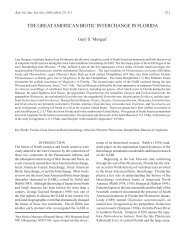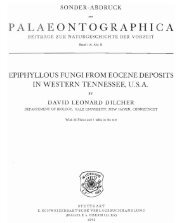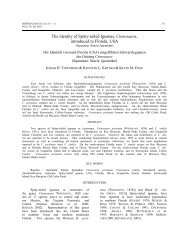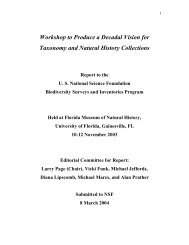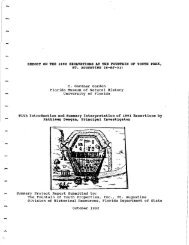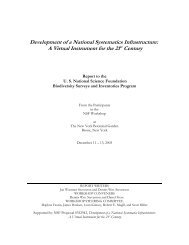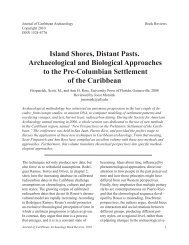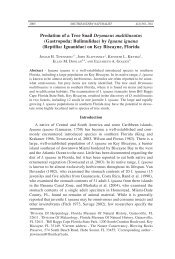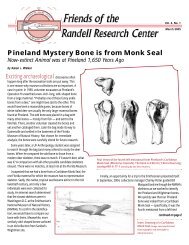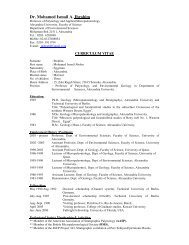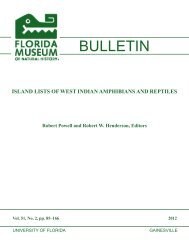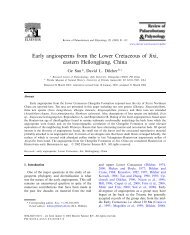COMPOSITIONAL ANALYSIS OF FRENCH COLONIAL CERAMICS ...
COMPOSITIONAL ANALYSIS OF FRENCH COLONIAL CERAMICS ...
COMPOSITIONAL ANALYSIS OF FRENCH COLONIAL CERAMICS ...
Create successful ePaper yourself
Turn your PDF publications into a flip-book with our unique Google optimized e-Paper software.
Compositional Analysis of French Colonial Ceramics Kelly et al.<br />
Results<br />
Instrumental Neutron Activation Analysis<br />
Before identifying compositional groups,<br />
exploratory data analyses were conducted on<br />
the thirty-three elemental abundance<br />
measurements. The elemental concentration<br />
of nickel (Ni) was dropped from subsequent<br />
analyses because many of the samples were<br />
below the detection limits. In addition two<br />
specimens, GUA037 and GUA045, were<br />
excluded from further analyses because of<br />
unusually high concentrations of metal that<br />
likely result from contamination of the<br />
samples. Specimen GUA037 had excessive<br />
concentrations in calcium, cesium, nickel,<br />
and the rare earth elements; specimen<br />
GUA045 exhibited an uncharacteristically<br />
high concentration of arsenic.<br />
A three-group structure was identified<br />
among the ceramic specimens: Group 1 (n =<br />
19), Group 2 (n = 16), and Group 3 (n = 4).<br />
The compositional groups can be graphically<br />
represented in principal component space<br />
(Figures 7 and 8) and in elemental space<br />
(Figure 9). Statistical tests based on<br />
Mahalanobis distance-derived probabilities<br />
using nine principal components (that is<br />
90.5% of the cumulative variance) support<br />
the graphical representation illustrating the<br />
group structure. A cut-off of 1% was<br />
generally used to refine the membership of<br />
Groups 1 and 2; however, exceptions were<br />
made because of the low numbers of samples<br />
in each of the compositional groups. The<br />
small membership size of compositional<br />
Group 3 precluded a robust statistical test of<br />
its validity. We therefore tested the<br />
probability of its samples having membership<br />
in Groups 1 and 2. The elevated statistical<br />
probability that specimen GUA019 has<br />
membership in Group 2 is anomalous and is<br />
partly due to the heterogeneous nature of<br />
compositional Group 2. Upon closer<br />
inspection (e.g., Figure 9), we decided to<br />
identify GUA019 as an unassigned sample.<br />
Nine specimens (19%) could not be assigned<br />
to any of the three compositional groups<br />
(Figures 8–9).<br />
The chemical characteristics describing the<br />
compositional groups are the following (see<br />
Figure 7): Group 1, in relation to Groups 2<br />
and 3 has elevated concentrations of<br />
manganese, rubidium, and the rare earth<br />
elements. Group 2, on the other hand, is<br />
enriched in the transition metals chromium,<br />
iron, antimony, scandium, titanium, and<br />
vanadium, relative to the other compositional<br />
groups. Compositional Group 3 is enriched in<br />
the transition metal element of cobalt and the<br />
alkali earth metal element of strontium.<br />
Finally, Group 1 is chemically more<br />
homogenous, whereas Groups 2 and 3 are<br />
somewhat more diverse. It is possible that<br />
analyses of additional samples would allow<br />
us to identify subgroups within the three<br />
compositional groups or assign more of the<br />
unknown specimens to one of the established<br />
groups.<br />
Tendencies and patterns can be found when<br />
comparing the archaeological attributes of the<br />
data belonging in the three compositional<br />
groups. Sampling issues aside, the ceramic<br />
specimens from six of the thirteen sites<br />
(River Mouth Grande Anse, Trois Rivières<br />
Grande Anse, Grande Baie, La Mahaudière,<br />
Grande Pointe, and Rue Dumanoir), have<br />
membership in a single compositional group<br />
(Group 1). All but one sample of industrial<br />
ceramics collected from Guadeloupe<br />
belonged to compositional Group 1. The<br />
same pattern exists for the wheel thrown<br />
utilitarian ceramic. Only one hand-built pot<br />
belongs to this group. Ceramic specimens<br />
from six sites (Pointe Petite Poterie, Point<br />
Journal of Caribbean Archaeology, Special Publication #2, 2008 95



